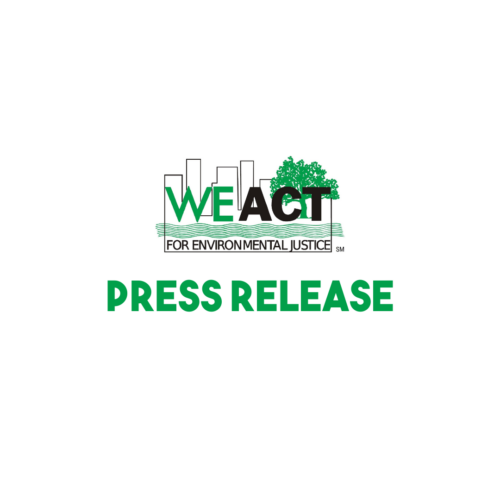FOR IMMEDIATE RELEASE
July 20, 2023
Media Contacts:
Jama Joseph, WE ACT for Environmental Justice, 646-951-1648, jama.joseph@weact.org
Charlie McAteer, Front and Centered, 917-696-1321, charlie@frontandcentered.org
James Urton, University of Washington, 206-543-2583, jurton@uw.edu
Kara Manke, University of California, Berkeley, 510-847-4891, kjmanke@berkeley.edu
WASHINGTON – Amidst the ongoing national debate on affirmative action in the wake of the U.S. Supreme Court decision that restricted race-conscious practices in higher education, a collaboration between academic researchers and environmental justice advocacy organizations found a need for targeted emission reduction policies to address pollution and adverse health disparities in communities of color.
The research paper, titled ”Air Quality Policy Should Quantify Effects on Disparities,” and published in the July 21 issue of Science, examines the impact that the Biden Administration’s Climate and Economic Justice Screening Tool (CEJST) may have on the potential emission reductions resulting from funding and other actions to communities that experience a racially disproportionate exposure to air pollution as a result of institutionalized bias in land use policies and practices. The research paper emphasizes the:
- Biden administration’s current method for identifying disadvantaged communities (CEJST), if used to identify where to prioritize emissions reductions, will not meaningfully reduce racial-ethnic air pollution disparities even if the emissions reductions are aggressive or very aggressive. The problem likely lies not in the overall approach (Justice40) but rather in the specific method used to identify disadvantaged communities, which is blind to communities’ racial/ethnic composition;
- need for decision-makers to examine the equity implications of regulations and policies and provide a straightforward and illustrative example of the type of analysis that can be supportive; and
- persistent exposure to pollution will continue based on racial-ethnic disparities if prior emission-reductions patterns were to continue into the future (even without Justice40) despite air pollution concentrations being reduced overall.
CEJST has played a critical role in the White House’s Justice40 Initiative, enabling the identification of disadvantaged communities burdened by climate, environmental, and economic challenges. These communities are then targeted for government programs. However, air pollution projection modeling incorporating potential emission-reductions from future investments in CEJST communities, indicates that air pollution disparities will not be adequately addressed and, in some cases, may worsen. While the use of the CEJST to guide air pollution emission reductions may reduce exposure disparities between low-income and higher-income households, as well as between CJEST-defined disadvantaged and non-disadvantaged communities, it falls short in addressing exposure disparities based on race and ethnicity.
This study underscores the imperative for decision-makers to thoroughly assess the equity ramifications of potential regulations and policies. The research offers a compelling and straightforward illustration of the kind of analysis that would be more effective. The findings reveal that if the current trajectory of emission reductions were to persist, air pollution concentrations would indeed decrease. However, the study also highlights a disconcerting reality: despite these improvements, relative disparities in exposure to air pollution by race-ethnicity would persist unabated.
“We have been optimistic about cutting GHG emissions in an effort to improve the conditions for front line communities who are currently carrying much of the pollution burden from the fossil fuel industry,” said Dana Johnson, Senior Director of Strategy and Federal Policy at WE ACT for Environmental Justice. “But we’re very aware of the dangers that some pathways to cutting emissions can have the reverse effect on EJ communities depending on the technology for achieving those reductions.”
“Today, the largest exposure disparities are by race-ethnicity; disparities by race are larger than, and statistically distinct from, those by income,” said Dr. Yuzhou Wang, the lead author and at the time of the research a PhD student at University of Washington. “Policies cannot ignore race if they wish to eliminate these disparities. These findings are about more than just the current administration’s efforts.”
Dr. Esther Min, Director of Environmental Health Research & Partnerships for the Front and Centered coalition in Washington State, adds: “Our latest research highlights the importance of addressing the root causes of disparities to create effective policy. Better policy solutions are possible when policies and research make space for the many experiences, knowledges, and critical analyses of frontline communities.”
“We were surprised by these findings,” said Dr. Julian Marshall, the corresponding author and a Professor of Civil and Environmental Engineering at University of Washington. “CEJST involves reducing emissions in disadvantaged communities, which is important for addressing exposure disparities, so we expected the CEJST approach would lead to bigger benefits than what we found.” He added, “This shows it’s time we start tracking impacts of proposed policies on exposure disparities, and chart a path to eliminating them.”
# # #
WE ACT for Environmental Justice is a Northern Manhattan membership-based organization whose mission is to build healthy communities by ensuring that people of color and/or low-income residents participate meaningfully in the creation of sound and fair environmental health and protection policies and practices. WE ACT has offices in New York and Washington, D.C. Visit us at weact.org and follow us on Facebook, Twitter, and Instagram.
